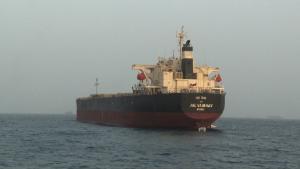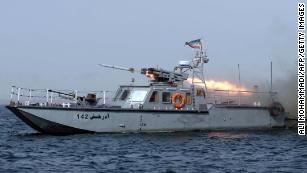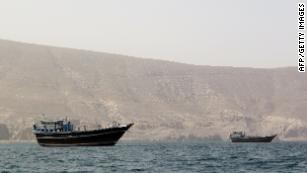All eyes on Strait of Hormuz as US-Iran tensions build
Fujairah, United Arab Emirates (CNN)Mystery still surrounds Iran's surprise naval exercisesin the strategic Strait of Hormuz this week, but no one here is ignoring it.
These military maneuvers are normally later in the year and heavily publicized by Iran. Not so these past few days. The only information about them has come US defense officials, describing "dozens of small boats" in a "massive military exercise."
West of the strait is the Persian Gulf; east is the Gulf of Oman.
US officials say Iran has begun a naval operation in the Middle East
The fact that I was able to take a rare ride Friday on a large tugboat out into the Gulf of Oman to see several dozen tankers anchored up, 100 more close by and shrouded in the haze, all waiting to make their run-up the strait to load their precious liquid cargo is an indication America's allies in the region want the story out, too, even if we do keep a safe distance from the Iranian navy.
The Strait of Hormuz has been Iran's go-to choke point for decades whenever they want to flag their anger.
One oil tanker attacked in this strategic narrow waterway on their southern shore could spike consumer gas prices globally.
They have plenty of potential targets -- 20% of the world's traded oil passes through it -- so whoever advised President Donald Trump to unilaterally pull out of the multinational agreement to cut Iran's pathway to making a nuclear bomb will have undoubtedly reminded him about the Strait of Hormuz.
If they didn't or he didn't hear them, Trump is likely to learn a whole lot more about them now. The sanctions he triggered on Iran by pulling out of the deal are about to begin to come in to effect.
Outrage by Iran's leaders when Trump took the decision in May is now being supercharged by small street protests against the government over the economy and the threat of more as the situation worsens.
US and allies looking at options to protect shipping lanes from Iranian threats
The Iranian riyal is down 25% against the dollar. Monday, US sanctions will kick in, banning the purchase of US dollars, gold and other precious metals, and in early November oil, shipping and ports will be hit by the second phase of the same sanctions.
Hardship is coming to Iran. Hormuz is the place they can transfer that pain to the rest of the world.
Across the Persian Gulf, preparations have been in play for years. Anyone Trump's age or 30 years younger here remembers the "tanker war" of the 1980s, when relations with Iran were so bad the US Navy escorted oil tankers through the straits.
The UAE, backed by its Saudi allies built a 220-mile, 48-inch oil pipeline from the Persian Gulf direct to Gulf of Oman, bypassing the Strait of Hormuz. It came online six years ago, helping future-proof in part the partners' oil security.
Pipelines also run to the Red Sea, another backup route, where Saudi officials announced Saturday they were restarting oil tankers on the shipping route that runs past Yemen, following an attack by Houthis who, they claim, are backed by Iran.
Days earlier, the Houthis announced an end to their long-standing threat to target Saudi and UAE shipping off Yemen's coast.
The region and its oil supplies are primed for volatility.
So far it's just rhetoric, like that from Iran's President and its supreme leader, both of whom threaten that if they cannot get their oil out of the Strait of Hormuz then no one will, and saber rattling in the shape of naval exercises.
What is clear is the Iranians are on maneuvers, Trump is in their crosshairs and Hormuz may be where they choose to strike.
News Courtesy: www.cnn.com













